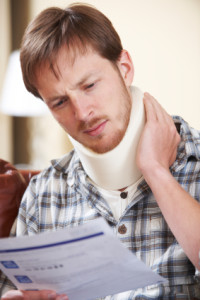 Any type of trauma to the head carries the risk of causing brain damage. About 2.5 million Americans were affected by an incident in which head trauma caused some form of brain damage in 2010. Each year, a significant number of U.S. patients are injured or killed by head trauma.
Any type of trauma to the head carries the risk of causing brain damage. About 2.5 million Americans were affected by an incident in which head trauma caused some form of brain damage in 2010. Each year, a significant number of U.S. patients are injured or killed by head trauma.
Types of Brain Damage and Head Trauma
Head trauma may be in the form of an open or closed injury. In an open head injury, an object has entered the brain, penetrating the skin and tissue and causing damage to specific areas of the brain. In a closed head injury, the brain has undergone trauma, but the skin and tissue remains intact. Both types of injuries can cause varying levels of brain damage and sometimes death.
Primary Brain Damage
Primary brain damage is damage which occurs immediately following head trauma. Contusions, lacerations, and blood clots may be present in or on the brain. The skull may be fractured, and may cause direct damage to the brain. Nerve damage may also occur as a result of the trauma. All of these types of damage carry the risk of decreased motor and cognitive function.
Secondary Brain Damage
Secondary brain damage is damage that develops over time as a result of head trauma, including:
- Changes in blood pressure
- Changes in nutritional absorption
- Breathing complications
- Swelling of the brain, called edema
- Heart irregularities
- Infections within the head
- Epilepsy and other seizure disorders
- Changes in pressure within the skull
Results of Brain Damage
The effects of brain damage may vary widely depending on the severity of the head trauma suffered and the area of the brain which was damaged. Immediately following trauma which has caused brain damage, patients may exhibit certain symptoms that can alert witnesses or family members to the damage. Immediate medical attention can sometimes mitigate the effects of brain damage if administered quickly enough.
If a patient that has suffered a head injury begins to show any of the following symptoms, seek medical attention as soon as possible:
- Abnormal behavior
- Slurring of words or speaking incoherently
- Becoming suddenly sleepy or dazed
- Showing pupils which are different sizes
- Losing consciousness
- Beginning to vomit
- Feeling sharp pain in the head or neck
- Losing the ability to move a limb
Long Term Physical Effects
In some cases, brain damage from head trauma causes certain changes to manifest permanently. While treatment may help to mitigate effects such as seizures and dizziness, if an area of the brain is damaged irreparably, the effects may be permanent. Sensory functions and motor functions may be impacted depending on the area of the brain which has suffered damage.
Physical changes which may manifest in patients following brain damage may include:
- Loss of sensation in different body areas
- Vision changes or loss
- Hearing changes or loss
- Taste and smell changes
- Weakness or paralysis in different body areas
- Coordination problems
Cognitive Effects
Cognitive effects may also vary widely from patient to patient, and may be permanent or may improve with treatment depending on the case. Communication problems are very common following head trauma, and may cause patients to have difficulty following conversations or understanding subtleties such as body language and inference. Patients may also have difficulty controlling emotions and understanding appropriate behavior following brain damage.
Other cognitive problems that may manifest following brain damage include:
- Issues with organizing and completing tasks
- Slower processing skills
- Concentration problems when there are background distractions
- Short-term memory problems
Brain Damage and Head Trauma Treatment
Immediately following head trauma, a patient may require surgery and stabilization procedures in order to prevent or mitigate brain damage. Medical professionals will focus on ensuring proper blood flow, stabilizing blood pressure, and limiting oxygen deprivation in order to prevent further damage. Patients may undergo scan tests to determine the location and type of brain damage. Medical professionals will often order emergency procedures or surgery once the extent of the damage has been diagnosed.
Long-term Care
After the immediate damage has been assessed and treated, physicians will often recommend treatment programs for rehabilitation. Physical therapy, speech therapy, and psychological therapy may be prescribed to assist the patient in recovery after an assessment has been made. The success of long-term treatment may vary depending on the case and the patient’s willingness to participate.
Sources:
“Head Injury – First Aid.” Medline Plus. U.S. National Library of Medicine, 26 Feb. 2014. Web. 17 Apr. 2014. <http://www.nlm.nih.gov/medlineplus/ency/article/000028.htm>
“NINDS Traumatic Brain Injury Information Page.” Traumatic Brain Injury Information Page: National Institute of Neurological Disorders and Stroke (NINDS). U.s.Department of Health and Human Services, 16 Apr. 2014. Web. 17 Apr. 2014. <http://www.ninds.nih.gov/disorders/tbi/tbi.htm>
“Traumatic Brain Injury.” Centers for Disease Control and Prevention. Centers for Disease Control and Prevention, 6 Mar. 2014. Web. 17 Apr. 2014. <http://www.cdc.gov/TraumaticBrainInjury/>
“Traumatic Brain Injury (TBI).” Traumatic Brain Injury (TBI). American Speech-Language-Hearing Association, 1 Jan. 2014. Web. 17 Apr. 2014. <http://www.asha.org/public/speech/disorders/tbi/>
